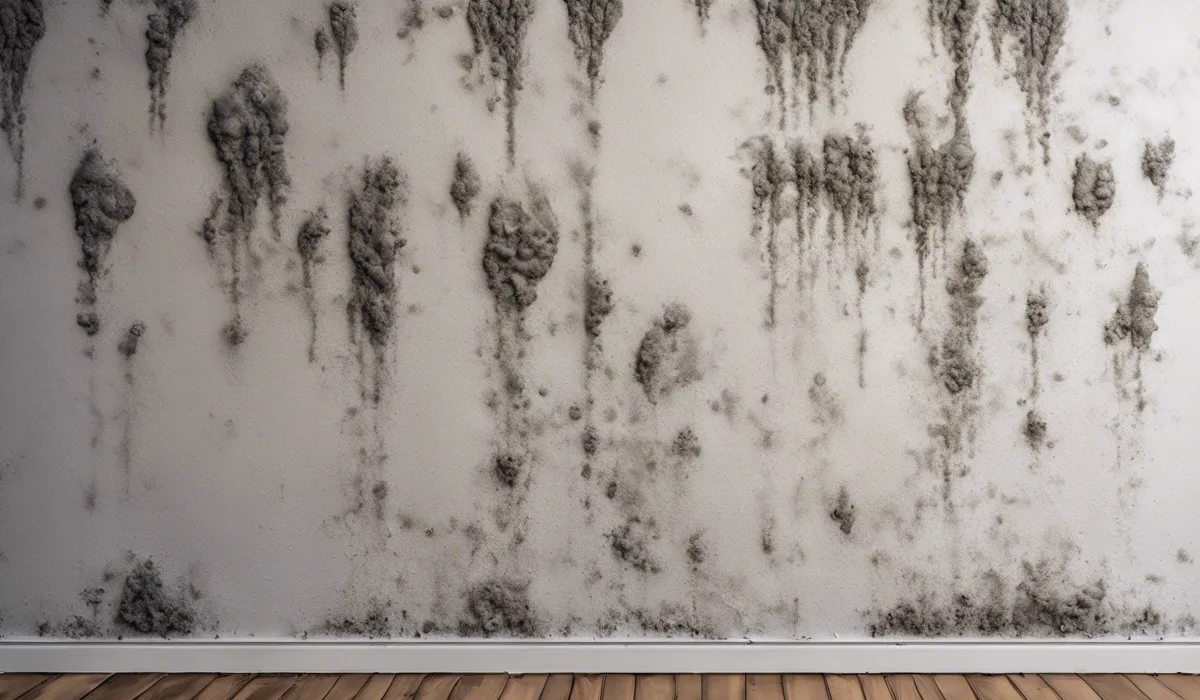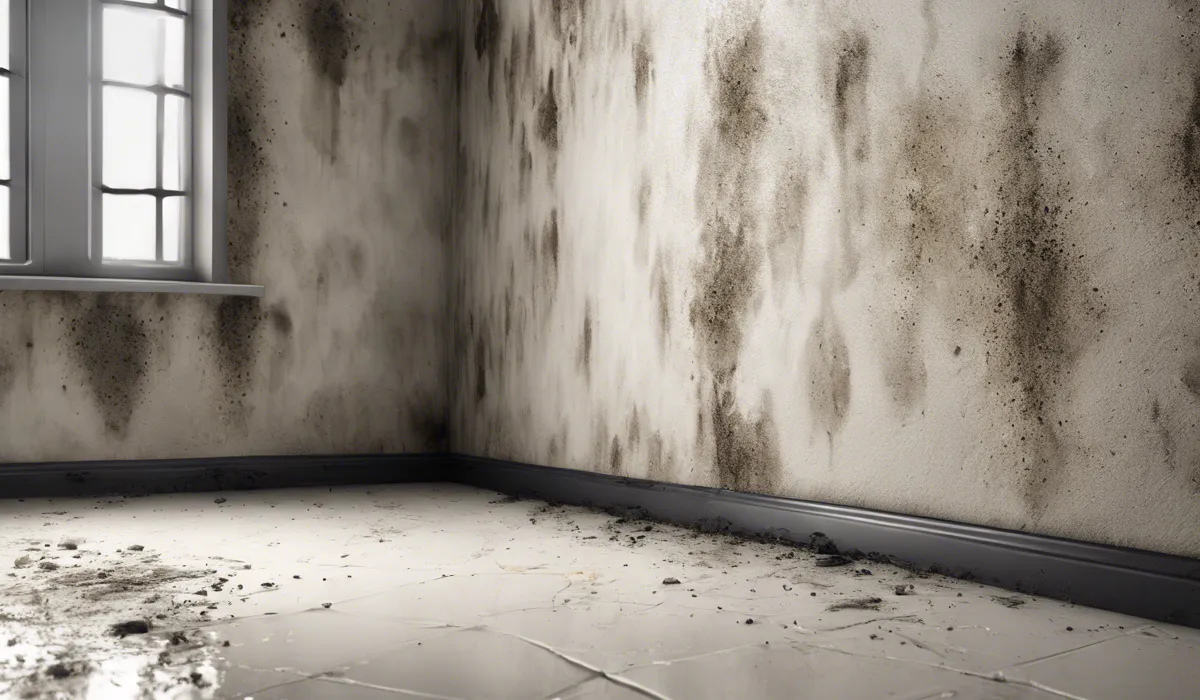Mold grows on walls due to moisture, lack of ventilation, and organic material presence. High humidity or water leaks create ideal conditions for spores to settle and multiply. Keeping walls dry and well-ventilated prevents mold growth.
Causes of Mold Growth on Walls

Excess Humidity and Moisture
Mold loves moisture. It thrives in damp environments where the humidity levels are high. When the air inside a home becomes too moist, it condenses on cooler surfaces like walls, providing a perfect breeding ground for mold spores.
Activities like cooking, showering, and drying clothes indoors can contribute to raising the humidity levels.
Without adequate control, this excess humidity becomes a key factor in mold proliferation on walls.
To understand just how critical humidity is for mold growth, it is important to note that mold can begin to grow when the humidity level in a room exceeds 60 percent.
This is why maintaining an indoor humidity level between 30 and 50 percent is crucial for preventing mold development.
Poor Ventilation
Poor ventilation traps moist air inside your home. Without a steady flow of fresh air to displace the damp air, moisture accumulates on wall surfaces.
This lack of air movement means that any moisture produced inside cannot escape, creating the perfect conditions for mold to grow.
Rooms that are often closed off or areas where the air does not circulate well are particularly prone to mold issues.
Ensuring that all areas of a home are well-ventilated is essential in safeguarding against mold growth.
Leaks in the Building Envelope
Water leaks from the roof, windows, or pipes can lead to mold growth on walls. When water infiltrates the building envelope, it can get trapped inside walls, providing a hidden source of moisture for mold to feed on.
Even small, seemingly insignificant leaks can have a big impact over time.
Regularly inspecting your home for leaks and addressing them promptly is a key step in preventing mold.
It’s not just about fixing visible leaks; it’s also about being proactive in checking for potential problem areas before they become major issues.
Condensation Due to Temperature Differentials
Condensation occurs when warm, moist air comes in contact with a cold surface, causing the water in the air to change from a gas to a liquid.
This often happens on walls that are poorly insulated or when there is a significant temperature difference between the inside and outside of a building.
Preventing condensation requires proper insulation and temperature control within the home.
By minimizing the temperature differential between the air and wall surfaces, you can reduce the likelihood of condensation and, consequently, mold growth.
Organic Materials on Walls Serving as a Food Source
Mold does not need a lot to survive, but it does need some form of organic material to feed on.
This can include common wall materials such as drywall paper, paint, and wallpaper glue. Even dust that settles on walls can provide enough organic material for mold to flourish.
Keeping walls clean and free of dust and organic debris is a simple yet effective way to starve mold and prevent it from taking hold.
Health Implications of Mold on Walls

Respiratory Issues and Allergies
Mold on walls can lead to a variety of respiratory problems and allergic reactions. Those living in mold-infested environments may experience coughing, sneezing, and irritation to the eyes and throat.
For individuals with asthma, mold can trigger more severe reactions, including asthma attacks.
It is not just the visible mold that causes issues; invisible mold spores in the air can also be inhaled, leading to allergic symptoms and respiratory complications.
Mycotoxin Production and Its Effects
Some types of mold produce toxic substances known as mycotoxins. These toxins can be harmful to humans and pets when they are inhaled, ingested, or come into contact with the skin.
Mycotoxins have been linked to a range of health issues, from acute poisoning to long-term effects like immune system suppression and neurological damage.
The presence of mycotoxins makes it even more crucial to address mold issues promptly and thoroughly, as they can remain harmful even after the mold itself has been killed.
Susceptible Populations
While mold can affect anyone, certain groups are more vulnerable to its effects. Immunocompromised individuals, such as those with HIV/AIDS or undergoing chemotherapy, may have a harder time fighting off mold infections.
Infants and the elderly are also at higher risk because their immune systems are either undeveloped or weakened.
For these populations, exposure to mold can lead to more serious health complications, making mold prevention and removal in homes and buildings even more critical.
Prevention and Remediation Strategies

Controlling Indoor Humidity Levels
Controlling the humidity inside your home is a powerful way to prevent mold growth. Using dehumidifiers and air conditioners can help maintain a consistent, low-humidity environment.
During humid months, it’s especially important to monitor the humidity levels and adjust your devices accordingly.
Simple actions like using exhaust fans in the bathroom and kitchen, and venting clothes dryers to the outside, can also help reduce moisture in the air.
Ensuring Proper Ventilation
Proper ventilation is essential to prevent mold growth. Ensure that your home has adequate airflow by using fans and opening windows when possible.
This allows for the exchange of moist indoor air with drier outdoor air.
Strategically placed vents, especially in areas like the bathroom and kitchen where moisture is commonly produced, can greatly reduce the risk of mold.
Prompt Repair of Leaks and Water Damage
Address leaks and water damage immediately to prevent mold from taking root. Inspect your home regularly for signs of water damage, such as stains or discoloration on walls and ceilings, and take action as soon as they are discovered.
Repairing leaks not only involves fixing the source but also includes drying out any wet materials, such as insulation or drywall, to prevent mold from growing.
Regular Cleaning and Maintenance
Regular cleaning can significantly reduce mold growth by removing the dust and organic materials that mold feeds on.
Wipe down walls and hard surfaces with mold-inhibiting cleaners, and vacuum carpets and upholstery regularly.
Maintain your home by checking for and sealing any cracks or openings that could allow moisture to enter.
This preventative maintenance not only keeps mold at bay but also improves your home’s overall durability.
Professional Mold Remediation Services
If mold has already established itself in your home, professional remediation may be necessary.
Mold remediation specialists have the tools and expertise to safely and effectively remove mold from your walls and other affected areas.
These experts can also help identify the underlying causes of mold growth and provide recommendations for preventing future issues. Remember, tackling mold early on can save time, money, and safeguard your health.
FAQs About Mold Growth on Walls
Why does mold form on walls?
Mold forms on walls primarily due to moisture accumulation, insufficient ventilation, and the presence of organic materials that mold can feed on.
What causes mold to grow on interior walls?
Interior mold growth is often caused by high humidity levels, water leaks, or condensation, which provide the moisture that mold spores need to grow.
Can mold on walls spread to other areas of the house?
Yes, mold on walls can release spores into the air, which can then settle in other moist areas and begin to grow, spreading throughout the house.
How can you prevent mold from growing on walls?
Preventing mold growth on walls involves controlling moisture levels, ensuring proper ventilation, and repairing any water leaks promptly.
Is it dangerous to live in a house with mold on the walls?
Living in a house with mold on the walls can be harmful to health, especially for individuals with allergies, asthma, or weakened immune systems.
Final Thoughts
Mold thrives on walls due to moisture accumulation, insufficient airflow, and the presence of organic materials.
Conditions such as high humidity and water leaks provide a perfect breeding ground for mold spores. To combat this, maintaining dry and well-ventilated wall surfaces is essential in preventing mold proliferation.
